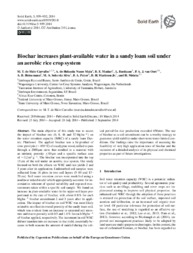Biochar increases plant-available water in a sandy loam soil under an aerobic rice crop system.
Biochar increases plant-available water in a sandy loam soil under an aerobic rice crop system.
Author(s): CARVALHO, M. T. de M.; MAIA, A. de H. N.; MADARI, B. E.; BASTIAANS, L.; VAN OORT, P. A. J.; HEINEMANN, A. B.; SILVA, M. A. S. da; PETTER, F. A.; MARIMON JUNIOR, B. H.; MEINKE, H.
Summary: The main objective of this study was to assess the impact of biochar rate (0, 8, 16 and 32 Mg ha-1) on the water retention capacity (WRC) of a sandy loam Dystric Plinthosol. The applied biochar was a by-product of slow pyrolysis (~450 °C) of eucalyptus wood, milled to pass through a 2000 micrometers sieve that resulted in a material with an intrinsic porosity less than or equal to 10 micrometers and a specific surface area of ~3.2 m2 g-1. The biochar was incorporated into the top 15 cm of the soil under an aerobic rice system. Our study focused on both the effects on WRC and rice yields 2 and 3 years after its application. Undisturbed soil samples were collected from 16 plots in two soil layers (5-10 and 15-20 cm). Soil water retention curves were modelled using a nonlinear mixed model which appropriately accounts for uncertainties inherent of spatial variability and repeated measurements taken within a specific soil sample. We found an increase in plant-available water in the upper soil layer proportional to the rate of biochar, with about 0.8% for each Mg ha-1 biochar amendment 2 and 3 years after its application. The impact of biochar on soil WRC was most likely related to an effect in overall porosity of the sandy loam soil, which was evident from an increase in saturated soil moisture and macro porosity with 0.5 and 1.6% for each Mg ha-1 of biochar applied, respectively. The increment in soil WRC did not translate into an increase in rice yield, essentially because in both seasons the amount of rainfall during the critical period for rice production exceeded 650 mm. The use of biochar as a soil amendment can be a worthy strategy to guarantee yield stability under short-term water-limited conditions. Our findings raise the importance of assessing the feasibility of very high application rates of biochar and the inclusion of a detailed analysis of its physical and chemical properties as part of future investigations.
Publication year: 2014
Types of publication: Journal article
Unit: Embrapa Rice & Beans
Observation
Some of Embrapa's publications are published as ePub files. To read them, use or download one of the following free software options to your computer or mobile device. Android: Google Play Books; IOS: iBooks; Windows and Linux: Calibre.
Access other publications
Access the Agricultural Research Database (BDPA) to consult Embrapa's full library collection and records.
Visit Embrapa Bookstore to purchase books and other publications sold by Embrapa.

